The Everglades

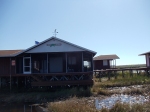
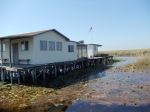

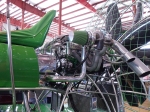
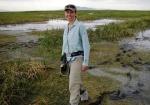
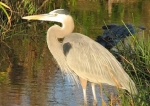


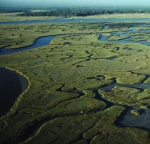


By Nicole Anderson
Environmental Journalist
Part 1: The Everglades: Unlocking History
Thousands of years ago the Everglades in southern Florida consisted of over four million acres of shallow sawgrass marsh, wet prairies and aquatic sloughs interspersed with tree islands. Fast forward to just over a century ago when the Everglades covered nearly 11,000 square miles of the southernmost tip of Florida. Wetlands that comprised the ecosystem consisted of hundreds of freshwater ponds, prairies, and forested uplands that supported a nutrient-rich plant and wildlife community.
Hundreds of years ago, the water in these areas flowed without constraint from the Kissimmee River to Lake Okeechobee and eventually found its way into the estuaries of Florida Bay. The Shallow sheetwater spanned nearly sixty miles across the state, though only six inches deep in some places, it was plenty to lend life to this unique landscape.
Early settlers saw the potential of this life giving area in the Everglades for farmland and housing communities and it wasn’t long until they began to drain the wetlands to transform them into an area that could be used for agriculture. In 1848 officials suggested that the Everglades be drained or rerouted and by 1882 continuing throughout the first half of the 20th century, canals were constructed that prompted land development.
Former Florida Governor Napoleon Bonaparte Broward initiated an effort in 1905 to make the land suitable for agriculture and development and promoted draining the Everglades as part of his plan. As the population in these new developments grew, so did the need to provide flood control to the residents. By 1947, Congress had formed the Central and Southern Florida Flood Control Project, and by 1948, C&SF had created one of the most effective water management systems in the world.
Today, the project consists of an extensive network of man-made canals, levees, and water-control configurations that channel 1.7 billion gallons of water daily from the Everglades out into the ocean. As a result of this loss of water, the natural characteristics of the marsh have become dramatically altered. With the disappearance of water, the natural habitats of wading birds, fish, and dozens of animals have disappeared.
Throughout the years, the landscape has been divided into several different areas; the Everglades Protection Area and Water Conservation Areas (WCA) 1, 2A, 2B, 3A, and 3B, and the Everglades National Park. Various state and federal governmental agencies oversee the WCAs and each area has its own unique access regulations, as well as its own unique environment and management plans.
Although, most of the man-made changes occurred fifty years ago management of these separate units is under constant study. In order to revive and protect the Everglades Florida is has organized an unprecedented restoration project. According to the South Florida Water Management District (SFWMD) the state of Florida’s “top priority is to improve the quality of life for all south Floridians, provide adequate water supply for south Florida’s growing population, and provide improved flood control, all while preserving America’s Everglades and what has been nicknamed Florida’s Liquid Heart – Lake Okeechobee – and protecting natural wildlife and plants for future generations.”
The Everglades are still considered to be a national treasure and are protected under the National Park Act of 1916. The Everglades National Park was established in 1947 in order to conserve the natural landscape and prevent further degradation of the fragile region. A National Park is just one of the many ways that Floridians are attempting to revive America’s Everglades before they are lost completely. The bottom line? The Everglades are now just half the size they were a century ago and their history has been wrought with conflict, beauty, and change throughout, and yet this unique wetland ecosystem may face its greatest threat of all time. The loss and diversion of the very life force it needs – water.
Part 2: The Everglades: A Lesson on Florida’s H2O
The state of Florida implemented the Comprehensive Everglades Restoration Plan (CERP) to restore one of the most unique and diverse ecosystems found east of the Mississippi. The Plan, as it is often referred to, is the framework that Florida will use to restore, protect, and preserve the water resources of central and southern Florida. The Plan was approved in the Water Resources Development Act of 2000 and is to be complete in next 30 years.
I can’t help but imagine what the Everglades may look like 30 years from now, especially with the current environmental challenges on the horizon such as the changing climate. You may ask the question of where Florida gets its water, how potential changes in the climate may affect the Everglades ecosystem, and whether there will be enough water in the Everglades to continue current activities such as hunting, fishing, and airboating. Some members from these user-groups have expressed concerns about the management of water in the Everglades and have joined forces to protect the landscape.
Several organizations are charged with protecting and properly managing the water of southern Florida. Organizations such as the Friends of the Everglades Water Management Group and the University of Florida are responsible for overseeing water use management. The Everglades National Park protects the southern 20% of the original Everglades. The United States Geological Survey (USGS) and the Army Corps of Engineers (ACOE) work alongside the South Florida Water Management District (SFWMD) to cooperatively manage and protect the water resources of the region.
Currently, the water supply in Florida sustains and nourishes more than 7.7 million people. This same water resource is also divided between environmental needs and agriculture. The regional water management system consists of over 2,000 miles of canals and more than 2,800 miles of levees or berms, 69 pump stations, 645 water control structures, and more than 700 culverts — all working together to protect the water supply and provide flood control.
According to the Southern Regional Water Program of Florida, the current state wide water balance consists of an average inflow of 26,000 million gallons per day (MGD) of surface water and 150,000 MGD of rainfall. The outflows look quite different. An average of 173,270 MGD of surface and groundwater, are lost as a form of evapo-transpiration, the process by which water is transferred from the land into the atmosphere by evaporation from the soil and other surfaces by transpiration from the plants growing there. Florida also uses an additional 2,730 MGD of consumptive use water. One must ask, does Florida have enough water for future generations and is there enough water in the Everglades to sustain this natural ecosystem?
Florida has over 7,700 warm-temperate and subtropical water bodies, and thousands of small permanent ponds and ephemeral pools. Lakes cover about 6% of the landscape, with swamps and marshes occupying another 10%. Lake Okeechobee covers 683 square miles with a maximum depth of only 16.5 feet. The majority of lakes in Florida are shallow and are fed by more than 1,700 rivers that are found in a variety of sizes. In this state there are over 300 artesian springs flowing at more than 100 (CFS) cubic feet per second.
These artesian springs come from underneath the ground in abundance. Groundwater is the main source of freshwater for public-supply, rural, and industrial uses, and is the source for at least half of the water used in irrigation. Groundwater provides important hydrological contributions to Florida’s estuaries and are associated with several principal economic activities such as transportation, fisheries, and military training bases. Meaning Florida’s 21 largest cities are built around an estuary or lie at the mouth of a river where it meets the ocean. In the past this provided an important means of transportation for trading goods and supplies. However, having a city at the mouth of the ocean may not continue to be a safe prospect due to current changes in the climate.
Climate change will affect water levels in Florida, specifically the Everglades where so many of the beloved activities of hunters, fisherman, airboaters, and hunt-camp owners take place. Whether you believe in climate change and global warming or not, the fact is glaciers are melting, and sea levels are on the rise and Florida is at current sea level.
The entire state of Florida, specifically the Everglades are extremely sensitive to changes in sea level. Rising seas and stronger storm surges are forcing more sea water into the Everglades, inundating mangroves, and threatening all of the low-lying islands within the ecosystem. Currently, sea water is forcing its way through the underground aquifers that supplied freshwater to southern Florida, leaving this resource of drinking water contaminated.
Flooding and change within the Everglades ecosystem are a fact; however, many plants and animals may not have a fast enough adaptation rate to survive these influxes of sea water into this fresh water system. As sea levels continue to rise and coastal populations increase, the need to pump water from the underground aquifers will become greater. Pumping will leave space in the aquifer for saltwater intrusion to occur. In simple terms, saline levels will rise where freshwater once stood, thus creating habitat issues and challenges for survival of wildlife species that currently call this place home.
Because of changes in the climate the SFWMD has to not only had to look at how water in southern Florida is managed but also how to counteract drought, sea level rise, and global warming. The Plan is currently being executed as water management organizations are finding ways to restore the flow of water from Lake Okeechobee to the Everglades National Park, and eventually to Florida Bay.
Part 3: The Everglades: Welcome to the Drawdown
Changes in the climate in southern Florida have caused the South Florida Water Management District (SFWMD) to not only look at how water in southern Florida is managed, but also how to counteract drought, sea-level rise, and global warming. Because of this, water management officials have had to speed up restoration plans in the Everglades and the ways they are doing this may surprise you.
A water drawdown may sound scary if you aren’t familiar with it. A scientific term used by hydrologists and civil engineers to explain the pressure in a well or aquifer and when a drawdown lowers the water level in a man-made reservoir or tank. In either case, a drawdown is the change in the headwaters, or water level, relative to the background condition.
The Everglades are shaped by water and fire. Throughout the last several decades, water management professionals have used drawdowns within the Everglades to move water from one area to another with the purpose of gradually draining the water within a certain area. Since 1978 the SFWMD has operated a drawdown program in area 2A that is designed to dry out the area to bring back plant species that were dormant or had drowned due to long years of water storage in the area.
A drawdown will dry out the layer of silt covering the bottom of the conservation area, thus permitting the eventual return of native vegetation. Some wetland ecosystems dry out completely during the dry season, then, once water is reintroduced to the area, new sprouts of vegetation appear.
When discussing wildlife in the area, sportsmen disagree with drawdowns because they believe this method kills off much of the wildlife. Different user-groups, such as hunters, fishermen, airboaters, and hunt-camp owners also express concern with the drastic use of a drawdown for water management.
Each unit of the Everglades reacts differently to a drawdown. If there is already a water control structure in place, a drawdown can be cost effective in controlling invasive plants. However, drawdowns can leave docks and hunt-camps high and dry which might negatively affect water-intake systems in hunt-camp buildings. We all know that without water it is impossible to launch boats or use the area for airboating and other recreational activities.
In the past, rising waters from rainfall prompted the Army Corps of Engineers (ACOE) to release water from Lake Okeechobee towards the east into the St. Lucie Estuary and out to sea. Lake Okeechobee is also drained prior to the arrival of a major storm to prevent potential flooding in the area and protect surrounding community housing, like it was in 2012 when the ACOE was preparing for Tropical Storm Isaac.
Even though some people get angry or upset with the drawdown method it seems to be the tried-and-true method of water control for the ACOE. Whether it is the right method to use remains a debate among community members throughout southern Florida.
Part 4: The Everglades: Hunting, Fishing & Airboating, Oh My!
By Nicole Anderson
Environmental Journalist
The Everglades is known around the world for its vastness in area and for its wildlife and a popular spot for hunting, fishing, frogging, airboating, and swamp buggy trails. User-groups such as hunters, fisherman, airboaters, and gladesmen who own camps within the Everglades spend a lot of time there. Several individuals I interviewed that participate in these activities had expressed concerns about how decisions made by water management officials will affect them and the activities that make their way of life.
In the early 1900s, hunting provided the necessary means of survival for many families. Originally, hunt-camps were built by men and their sons as a shelter when they were away from home for months at a time. These men, eventually nicknamed “Gladesmen,” developed an intimate relationship with the environment and over the years have become knowledgeable stewards of the land. Hunt-camp owners currently claim over 75 hunt-camps that dot the landscape throughout units 2A and 3A –B.
Different species that can be found and hunted in the different units of the Everglades are alligator, Osceola Turkey, wild boar, waterfowl, Mourning Dove, and the Whitetail Deer. Most of these hunts take place on either on private land or public waters, within different units of Lake Okeechobee and the Florida Everglades. Sometimes hunters choose to use a hunting guide because they know exactly where to go and how to hunt a certain species, such as the turkey. The Everglades in southern Florida are maintained year-round for turkey hunting by mowing and burning, as well as feeding the turkeys at what are called food plots by using automatic solar-powered feeders. These areas offer some of the most pristine hunting habitats in southern Florida.
Deer hunting has taken place in the Everglades since the early 1980s during the Whitetail Deer season. Hunters are just one of several user-groups that participate in activities taking place in the Everglades. Hunters have also expressed concern about the water levels within the units they use. Many of them own or lease hunt-camps in the area but if there isn’t enough water in that unit, they can’t get to their camp by airboat. If too much water is in the area, the deer and turkeys aren’t. Water management officers walk a fine line between too much and not enough. Over the last several years, anglers have expressed many of these same concerns.
The Everglades and Lake Okeechobee is, from what I am told, a fine place to fish. I asked what anglers enjoyed fishing for and what method they liked best. The fishermen and women, explained that bowfishing is one of the best ways to fish in any of the units of the Everglades. These anglers hunt or fish for gar, tilapia, bowfin, plecos, and catfish and at certain times of the year.
Bowfishing and spearfishing are legal everywhere fishing is. Gigging is yet another type of spearfishing generally used to hunt small fish or game by using a multi-pronged spear. Usually the harvested wildlife taken by gigging include freshwater suckers, saltwater flounder, and small game such as frogs—all of which are usually hunted at night.
Then there are the more traditional anglers who choose to use the rod-and-reel fishing technique in some of the most beautiful places that Florida has to offer. Rod-and-reel fishing is most popular on some of the freshwater lakes and the world famous Mosquito Lagoon in Volusia County that covers 4,740 acres.
Both hunters and anglers have found that the best form of transportation to get around while hunting and fishing in the Everglades is either a swamp buggy, or an airboat. The airboat is a popular method of getting from point A to B but also provides an exciting adventure as it skims across a shallow section of sheetwater. Airboat tour companies provide visitors to the Everglades a thrilling adventure. A visitor coming to the Everglades can enjoy fishing, hunting, or coming face-to-face with animals you may not see anywhere else in the world while onboard an airboat.
Airboating in Florida isn’t just a fad; it is a way of life. There are several airboating clubs avid airboaters can join, such as the Broward County Airboat, Halftrack and Conservation Club, or the Seminole County Airboat Club. The majority of these groups work together, along with fishermen, hunters, and gladesmen hunt-camp owners, to ensure that the Everglades, wetlands, and pinewoods are preserved and protected in their wild and natural state. Hunters, fishers, and airboaters of the Everglades are integrated with the wetlands and their wildlife. These groups, especially Gladesmen, have a lot at stake when changes due to urban sprawl and development affect the balance of life and water in this area.
The arrival of Gladesmen into the Everglades has changed with development and urban sprawl in the area. The Gladesmen culture has had to adapt to an ever-changing landscape much in the same way the animals have had to do. However, Gladesmen and their families have voiced concerns about increased development and the designation of the Everglades as a National Park because it has limited the ability of this culture to simply live off the land.
Gladesmen and sportsmen, alike, are often described as keen observers of the wilderness that sometimes spending weeks at a time walking through endless sawgrass marshes and finding their ways through the labyrinths of mangrove forests. Because of their presence, they have been able to interpret subtle signs within the landscape such as depression in the mud and the presence or loss of certain species of animals or birds; without this culture, it is possible that the Everglades as a whole could be lost as well.
As these groups come together to promote the welfare and protection of these pristine areas in southern Florida, they also assure that sportsmen are able to continue to use the units in the Everglades for activities they find important to their way of life, such as hunting, fishing, and frogging. These groups also promote the enactment of fair game laws and the enforcement of these laws for future generations to come.
Nicole Anderson, MSC
Freelance Journalist
Murray, Utah
nma9999@xmission.com
385-355-5062
